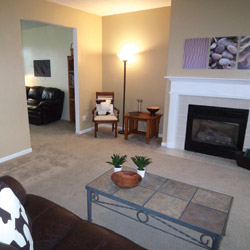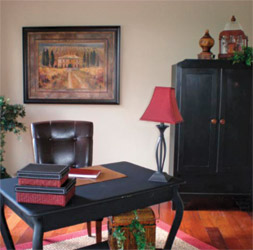When you walk into a house for the first time, you rely on your senses to get a feel for the space. Colors, sounds, scents and textures all help you determine—sometimes unconsciously—if you’re in a place that soothes the soul or creates anxiety. If you’re attending a dinner party at a friend’s house, you might not particularly care about such things, but if you’re searching for the right home to buy, they become incredibly important.
It’s said that home buyers decide whether or not they can live in a house within 90 seconds of walking in the front door. But what can you really see in just 90 seconds? Taking in the overall feel of the house is about all you can do. Colors, textures, and the type and arrangement of furniture become vitally important for that first minute and a half. If every flat surface in the house is covered in clutter, or that wallpaper from decades ago has yet to be taken down, there’s a good chance buyers will turn around and walk away—leaving the house on the market for months. But if sellers address details like wall and floor coverings, cleanliness, and the ideal arrangement of furniture, there’s a much better chance that their homes will move quickly—even in a down market!
Yet most sellers don’t know which changes will make the biggest impact in their homes. That’s where professional home stagers come in. With the knowledge of what homebuyers look for, stagers are able to transform homes, often through several minor changes, giving them immediate buyer appeal.
Showcasing Space
Diann Crompton of StarStone Home Staging Service defines staging as “Utilizing space in the best possible way to appeal to the broadest range of buyers.” A common misperception exists that stagers are decorators, but that’s not the case. “Staging is about showcasing space, while decorating is showcasing a specific style,” she explained. “When you hire a decorator, you have definite likes and dislikes. Decorating, then, becomes about purchasing new ‘stuff.’ Staging, for me, is about creativity—using your client’s items and thinking outside the box to make the best impression.”
Because prospective buyers often take just seconds to decide if they like a home, sellers do themselves a disservice by not utilizing that creativity to make the best first impression. Statistics show that consulting with a professional home stager could mean the difference between a house being on the market for an average of 182 days (for unstaged homes) and 37 days (for staged homes). With those numbers, it’s wise to consult a certified home stager before putting your house on the market. Before is the operative word here, as studies show that homes that are staged before being put up for sale fare much better than those that sit on the market for some time before being staged—89 percent less time, according to the Real Estate Staging Association.
We’ve Come a Long Way
While home staging became popular in some parts of the United States about 75 years ago, it was little-known in central Illinois until recently. Colleen McLinden, who founded Impact! Home Staging in 2004, said that, locally, “very few people knew what staging even was five years ago. I spent so much time explaining it.”
The owner of Simply Organized and Staged, Tracy Molendi had always enjoyed organizing and decorating. When her husband became a home inspector, she worked to promote his company, which led to her passion for staging. After working in the field for several years, Molendi earned her staging certification in 2007. Since then, and because of the increased recognition of the importance of staging, her business has continued to grow, so much that she was able to hire two employees this year.
Although she officially launched her business earlier this year, Crompton has been staging homes since 1992. “I was blessed to have a Realtor who understood the value of staging,” she explained. “Having two small children at the time, you could imagine the toys! [Our Realtor] taught me about using your space and creative spirit, and our home sold in six days for more than the list price! I learned that staging works.”
Many Realtors have teamed up with home stagers and offer staging to their clients as part of their services. By doing so, Realtors increase the appeal of clients’ homes, which boosts the foot traffic of buyers, creates more and higher offers, and sells homes faster.
 Staging to Sell, Staging to Live
Staging to Sell, Staging to Live
Not all staging is done on homes that are going on the market, however. “In staging to sell, the goal is to get the potential buyers to envision themselves living in that space,” Crompton explained. “[This] involves limited use of furniture, neutral wall and floor colors, furniture arrangements that may not be comfortable for TV viewing, being Q-tip clean, and definitely no clutter. It’s a bit different when you stage to live. You are still using the space to its best advantage, but you are able to add personal touches.”
McLinden agreed. “When staging a home to sell,” she said, “it is form over function, and when staging to live, the reverse philosophy applies.”
In any case, a stager takes into account what a homeowner has in mind for the finished space and creates a plan. Some need just a bit of advice and can then execute the plans themselves. McLinden has found that, in this economy, most of her clients want to save money by doing the brunt of the labor themselves. “I instruct the home sellers, they do the work, and I return to tweak,” she said.
Others require a staging team to come in and do everything from cleaning up clutter and painting walls to switching out furniture and adding trendy accessories. Molendi also partners with her husband’s home inspection company to offer clients the best deal when prepping their homes for sale. This prevents surprises from buyers’ inspection reports, which can significantly lower the sale price or negate a deal entirely.
 Sizing Up the Home
Sizing Up the Home
What is the first thing a stager looks for upon entering a home? “Everything!” Crompton exclaimed. “When I walk a property, I look through the eyes of the buyer. I look at everything from curb appeal, space, flow, cleanliness, clutter, color…I would not be doing my clients any favors if the consultation was not comprehensive.
“The term ‘staging’ is thrown around a lot these days,” she continued. “People need to understand that it is much more than flowers and music. There are very definite things that most homes must change in order to sell. Clutter, cleaning, general maintenance and color need the most attention. This does not sound like much, but it makes a big difference.”
With that in mind, Crompton said her ideal clients are homeowners who are able to see through the eyes of the buyer and are not afraid to make changes. “That is very difficult to do when you are making the mortgage payments, and the Realtor and stager are telling you that your home is a product,” she said. “[When] clients understand the value of staging, they have become my ideal clients. You can stage anything once your client ‘gets it.’”
When Molendi stages a home, she starts at the curb and walks through the property to determine the feel of things—both positive and negative. She notes where clutter might prevent buyers from seeing the true beauty of a room and whether furniture is arranged in ways that make the rooms feel as large as possible. In this market, buyers want to get the most for their money, and oversized furniture that makes a living room look half as big as it is can really hurt a seller’s chances.
That doesn’t mean that new furniture is required—stagers are usually able to suggest ways to rearrange the furniture their clients already have. “We love helping [our clients] create that look with what’s already in their home,” said Molendi. “By the end of it, they’re so excited with how the room looks!” With vacant homes or new construction, however, stagers must sometimes bring in everything from furniture to accessories, and even paint, so most have an inventory of items to use for staging. Some even bring tables, loveseats or pictures from their own homes!
Molendi noted that about 40 percent of her business comes from staging vacant homes, so she must have a decent inventory of furniture and accessories on hand. “I try to buy things that are classic, and most items are not actually used in the vacant homes we stage, so they tend to last a long time,” she said, explaining that it’s not necessary to rotate the staged furniture and accessories very often. She also rents out some of her inventory to homeowners who live in the homes they are trying to sell.
 Whatever’s Necessary
Whatever’s Necessary
When the homes are occupied, it takes Molendi and her team between two and four hours to stage. Vacant homes tend to take more time because there’s often no furniture or accessories to make the place feel homey. These jobs can take up to a day and a half, depending on what needs to be done. “We do whatever’s necessary,” said Molendi, “even painting rooms or cabinet doors.”
Some stagers have a list of trusted contractors, while others do all of the work themselves, within reason. If walls in a new construction need to be painted, Molendi and her team don their painting clothes. If the kitchen of an occupied house hasn’t been deep-cleaned in several years, they break out their rubber gloves.
For home stagers, no two days are exactly the same. One day, they may be offering home organization suggestions to a couple of empty nesters, and the next they could be hauling furniture to fill out a master suite. As professionals like Molendi, Crompton and McLinden work in central Illinois, they are helping to educate the public about the importance of staging before putting a house on the market. Thinking of selling? You might consider contacting a stager to make the most of your home. a&s


